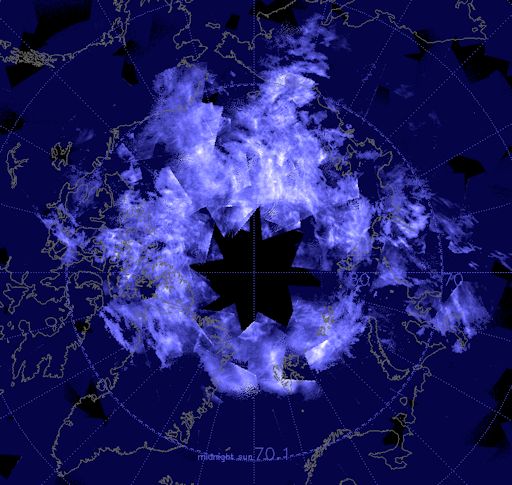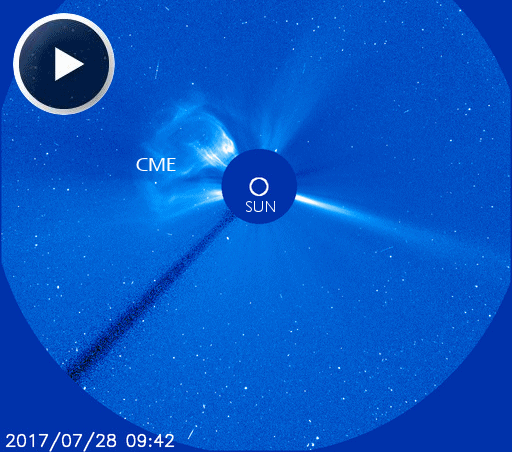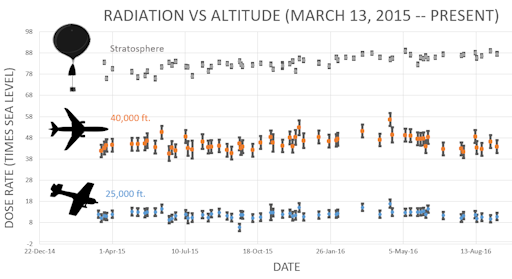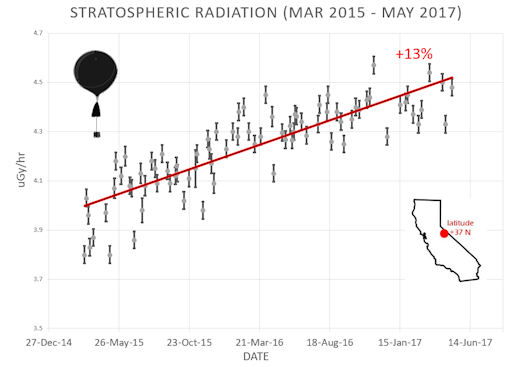Lights Over lapland is excited to announce that Autumn Aurora Adventures are available for immediate booking! Reserve your adventure of a lifetime in Abisko National Park, Sweden today! | | |
ANIMATED SOLAR ECLIPSE MAPS: The Great American Solar Eclipse is less than one month away. How much of the sun will be covered over your home town? A great way to find out: Animated eclipse maps created by science-artist Larry Koehn. On his web site, there are individual maps for all 50 US states as well as little-known eclipse zones in Canada and Europe. Check it out! Free: Solar Flare Alerts
NOCTILUCENT CLOUDS FROM SPACE: This week, sky watchers near the Arctic Circle have reported nightly displays of bright noctilucent clouds. The silvery ripples of NLCs look amazing from the ground, but they look even better from space. NASA's AIM spacecraft took this picture of the entire Arctic surrounded by an electric-blue glow on July 24th:

Regular readers of Spaceweather.com have been waiting for this image since June. Normally, AIM transmits pictures of NLCs every day, but the regular flow of data was interrupted months ago. The reason has to do with the spacecraft's orbit. Since AIM was launched in 2007, its orbit has been precessing--that is, slowly rotating with respect to the planet below. Eventually, accumulated changes in AIM's orbital elements required a new way of pointing the spacecraft's instruments. Mission controllers have been working on that problem all summer long--and it has finally been solved.
"We are thrilled to be back in business," says Prof. Cora Randall, a member of the AIM science team at the University of Colorado's Department of Atmospheric and Oceanic Sciences. "Our orbit will continue to evolve, but at this point we believe that we know how to control the pointing under the anticipated orbit parameters."
NLCs are, essentially, clouds of frosted meteor smoke. They form when wisps of summertime water vapor rise toward the top of Earth's atmosphere. Water molecules stick to the microscopic debris of disintegrated meteoroids, assembling themselves into tiny crystals of ice that glow beautifully in sunlight at the edge of space.
Thanks to the efforts of the AIM team, you can see these strange clouds not only from Earth, but also from Earth orbit. AIM images are published every day right here on Spaceweather.com.
Realtime Noctilucent Cloud Photo Gallery
FARSIDE EXPLOSIONS CONTINUE: Space-based observatories recorded another powerful explosion on the farside of the sun today. The blast hurled a bright coronal mass ejection (CME) over the sun's northeastern limb, shown here in a movie from the Solar and Heliospheric Observatory (SOHO):

NASA's STEREO-A spacecraft, which has a partial view of the sun's farside, pinpointed the explosion: The source appears to be old sunspot AR2665. The huge active region crossed the Earthside of the sun in early July, sparking moderately strong geomagnetic storms when it faced our planet. Apparently, it is still active, producing at least three significant CMEs since it began its farside transit more than 10 days ago.
AR2665 will spin back around to face Earth in early August. If the sunspot continues to explode, it could bring a new round of geomagnetic storms and auroras to our planet. Stay tuned. Free: Solar Flare Alerts
Realtime Noctilucent Cloud Photo Gallery
SOLAR ECLIPSE VIEWING GLASSES: Get ready for the Great American Solar Eclipse! Earth to Sky's safe solar glasses will allow you to view any phase of the upcoming solar eclipse without fear of damage to your eyes. The Family Pack includes 3 pairs of glasses and costs only $29.95. And there's a bonus. They have all been to the edge of space:

On June 23, 2017, the students of Earth to Sky Calculus flew a payload-full of solar glasses to the stratosphere onboard a high-altitude space weather balloon. The glasses ascended more than 95,000 feet above the Sierra Nevada mountains of central California before parachuting back to Earth.
Each Family Pack of solar eclipse glasses comes with a unique gift card showing the glasses floating at the top of Earth's atmosphere. The interior of the card tells the story of the flight and confirms that these items have been to the edge of space and back again.
More items from the edge of space may be found in the Earth to Sky Store. All proceeds support our Solar Eclipse Balloon Network and hands-on STEM education.
Far Out Gifts: Earth to Sky Store
All proceeds support hands-on STEM education
Realtime Space Weather Photo Gallery
Realtime Aurora Photo Gallery
Every night, a network of
NASA all-sky cameras scans the skies above the United States for meteoritic fireballs. Automated software maintained by NASA's Meteoroid Environment Office calculates their orbits, velocity, penetration depth in Earth's atmosphere and many other characteristics. Daily results are presented here on Spaceweather.com.
On Jul. 28, 2017, the network reported 27 fireballs.
(19 sporadics, 3 Perseids, 3 Southern delta Aquariids, 2 alpha Capricornids)

In this diagram of the inner solar system, all of the fireball orbits intersect at a single point--Earth. The orbits are color-coded by velocity, from slow (red) to fast (blue). [Larger image] [movies]
Potentially Hazardous Asteroids (
PHAs) are space rocks larger than approximately 100m that can come closer to Earth than 0.05 AU. None of the known PHAs is on a collision course with our planet, although astronomers are finding
new ones all the time.
On July 28, 2017 there were 1803 potentially hazardous asteroids.
 |
Recent & Upcoming Earth-asteroid encounters: | Asteroid | Date(UT) | Miss Distance | Velocity (km/s) | Diameter (m) |
| 2017 OL1 | 2017-Jul-23 | 14.9 LD | 12.1 | 167 |
| 2017 BS5 | 2017-Jul-23 | 3.1 LD | 5.8 | 54 |
| 2017 OM1 | 2017-Jul-25 | 2.3 LD | 15.9 | 77 |
| 2017 OE1 | 2017-Jul-25 | 8.7 LD | 17.3 | 45 |
| 2017 OE7 | 2017-Jul-26 | 4.5 LD | 4.7 | 19 |
| 2011 CC22 | 2017-Aug-04 | 15.5 LD | 18.4 | 186 |
| 2017 NB7 | 2017-Aug-06 | 6.9 LD | 6 | 80 |
| 2017 OF7 | 2017-Aug-10 | 19.2 LD | 8.1 | 90 |
| 2014 OA339 | 2017-Aug-13 | 12.3 LD | 10 | 47 |
| 3122 | 2017-Sep-01 | 18.5 LD | 13.5 | 5376 |
| 2014 RC | 2017-Sep-11 | 15.1 LD | 8.9 | 16 |
Notes: LD means "Lunar Distance." 1 LD = 384,401 km, the distance between Earth and the Moon. 1 LD also equals 0.00256 AU. MAG is the visual magnitude of the asteroid on the date of closest approach. | | Cosmic Rays in the Atmosphere |
Readers, thank you for your patience while we continue to develop this new section of Spaceweather.com. We've been working to streamline our data reduction, allowing us to post results from balloon flights much more rapidly, and we have developed a new data product, shown here:

This plot displays radiation measurements not only in the stratosphere, but also at aviation altitudes. Dose rates are expessed as multiples of sea level. For instance, we see that boarding a plane that flies at 25,000 feet exposes passengers to dose rates ~10x higher than sea level. At 40,000 feet, the multiplier is closer to 50x. These measurements are made by our usual cosmic ray payload as it passes through aviation altitudes en route to the stratosphere over California.
What is this all about? Approximately once a week, Spaceweather.com and the students of Earth to Sky Calculus fly space weather balloons to the stratosphere over California. These balloons are equipped with radiation sensors that detect cosmic rays, a surprisingly "down to Earth" form of space weather. Cosmic rays can seed clouds, trigger lightning, and penetrate commercial airplanes. Furthermore, there are studies ( #1, #2, #3, #4) linking cosmic rays with cardiac arrhythmias and sudden cardiac death in the general population. Our latest measurements show that cosmic rays are intensifying, with an increase of more than 13% since 2015:

Why are cosmic rays intensifying? The main reason is the sun. Solar storm clouds such as coronal mass ejections (CMEs) sweep aside cosmic rays when they pass by Earth. During Solar Maximum, CMEs are abundant and cosmic rays are held at bay. Now, however, the solar cycle is swinging toward Solar Minimum, allowing cosmic rays to return. Another reason could be the weakening of Earth's magnetic field, which helps protect us from deep-space radiation.
The radiation sensors onboard our helium balloons detect X-rays and gamma-rays in the energy range 10 keV to 20 MeV. These energies span the range of medical X-ray machines and airport security scanners.
The data points in the graph above correspond to the peak of the Reneger-Pfotzer maximum, which lies about 67,000 feet above central California. When cosmic rays crash into Earth's atmosphere, they produce a spray of secondary particles that is most intense at the entrance to the stratosphere. Physicists Eric Reneger and Georg Pfotzer discovered the maximum using balloons in the 1930s and it is what we are measuring today.
| | The official U.S. government space weather bureau |
| | The first place to look for information about sundogs, pillars, rainbows and related phenomena. |
| | Researchers call it a "Hubble for the sun." SDO is the most advanced solar observatory ever. |
| | 3D views of the sun from NASA's Solar and Terrestrial Relations Observatory |
| | Realtime and archival images of the Sun from SOHO. |
| | from the NOAA Space Environment Center |
| | a proud supporter of science education and Spaceweather.com |
| | fun to read, but should be taken with a grain of salt! Forecasts looking ahead more than a few days are often wrong. |
| | from the NOAA Space Environment Center |
| | the underlying science of space weather |
 | Beautyz for top beauty products reviews and their buying guides |
 | Reviews here can help you to pick up best memory foam mattresses. |
| | These links help Spaceweather.com stay online. Thank you to our supporters! |
| | | | | | |

